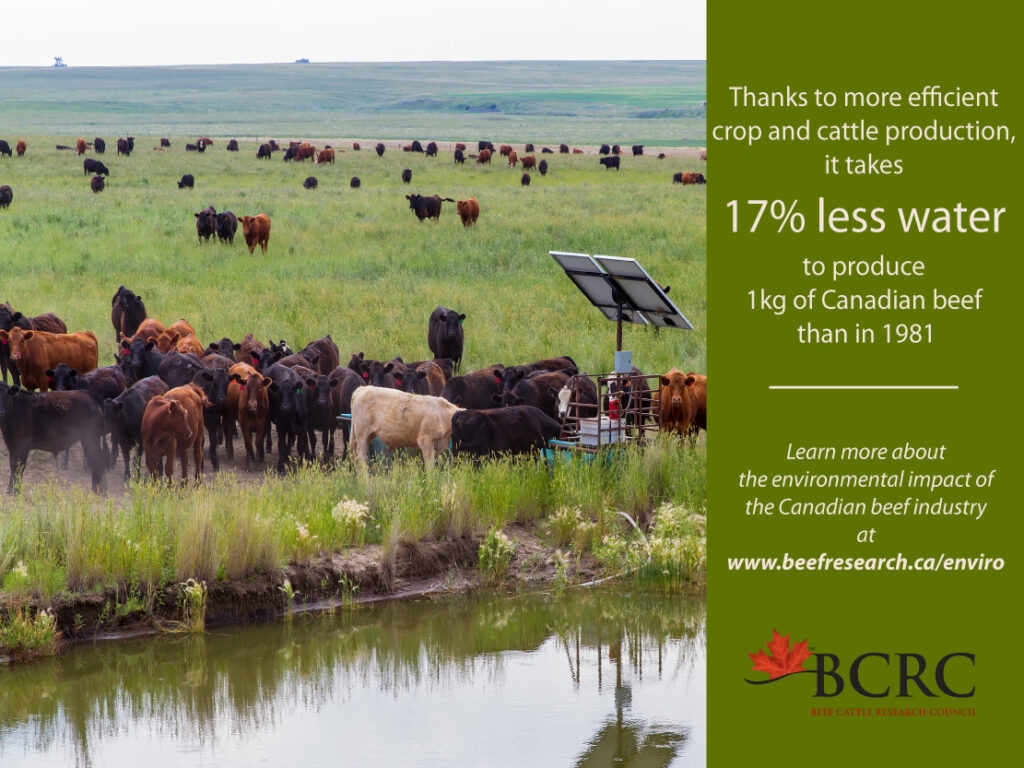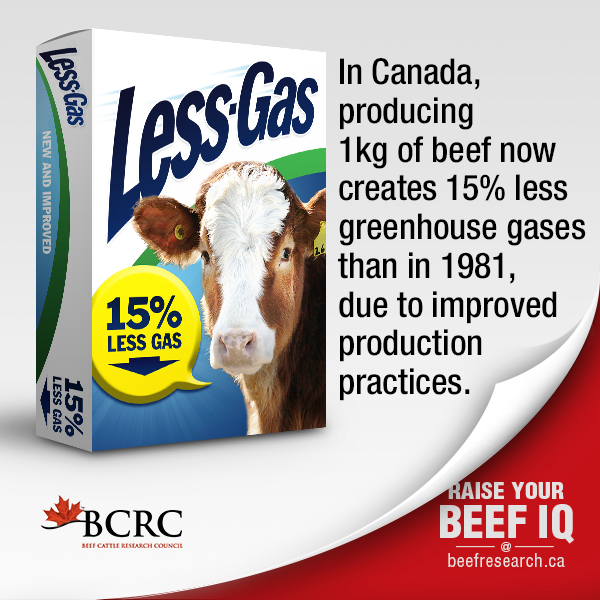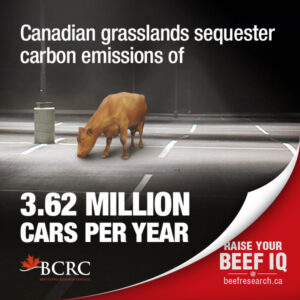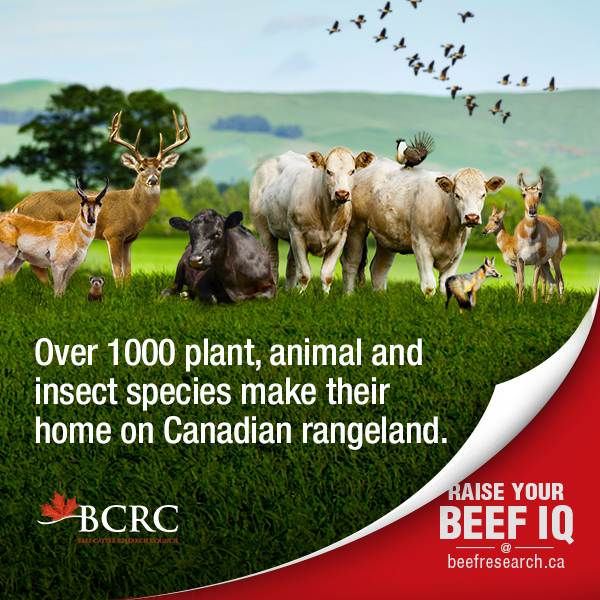Are Cattle Drinking Canada Dry?
We often see headlines about how human lifestyle and dietary choices (particularly beef consumption) can impact environmental sustainability. These headlines are often about greenhouse gases, but water use has become a part of this conversation as well. Vilifying headlines and simple, partial arguments are interesting and emotional; that sells papers and gets clicks. Complex, science-based facts about the positive impacts cattle have on the environment and the need for both crops and cattle across the country’s diverse landscape are less exciting, but here they are:
Beef cattle use water
Make no mistake – it does take more water to produce a pound of uncooked, boneless beef (over 1,800 gallons/6814 liters) than to produce a pound of dry peas (178 gallons/674 liters), dry beans (488 gallons/1847 liters) or dry lentils (577 gallons/2184 liters), or any other protein crop, but this is only one of many pieces of information to consider. The pastures and feed crops that beef cattle eat account for nearly all (99%) of the water used in beef production.
Does that mean that the land used to raise cattle should be converted to crop production? Not necessarily. There are many reasons why not all land is suitable for cultivated agriculture and why raising beef plays an important role in sustainably feeding the population.
Crops are thirstier than pastures
Water use statistics look considerably different when we balance water use with water availability. Here’s an example. At 178 gallons per pound, dry peas have a very low water footprint. In 2011, Canada harvested 5.6 billion pounds of dry peas from 2.4 million acres of land. This works out to 414,562 gallons of water per acre of land used for dry pea production.

(note: differences due to rounding errors)
In contrast, producing a pound of beef requires over 1,800 gallons of water. In 2011, Canada produced 2.46 billion pounds of beef, from 57 million acres of land to grow the pasture, forage and other feed for the cattle herd. This works out to 78,813 gallons per acre of land used for beef production.

(note: differences due to rounding errors)
What if we cultivated that grassland and tried to grow dry peas instead? It probably wouldn’t work too well. Dry peas need more than five times as much water (414,652 ÷ 78,813 = 5.3) than the grass does. Much of the land used to raise forage for beef cattle doesn’t receive adequate moisture or have the right soil conditions to support crop production, but it can produce grass that can thrive in drier conditions.
Cattle produce environmentally and economically sustainable protein on land that can’t support crops
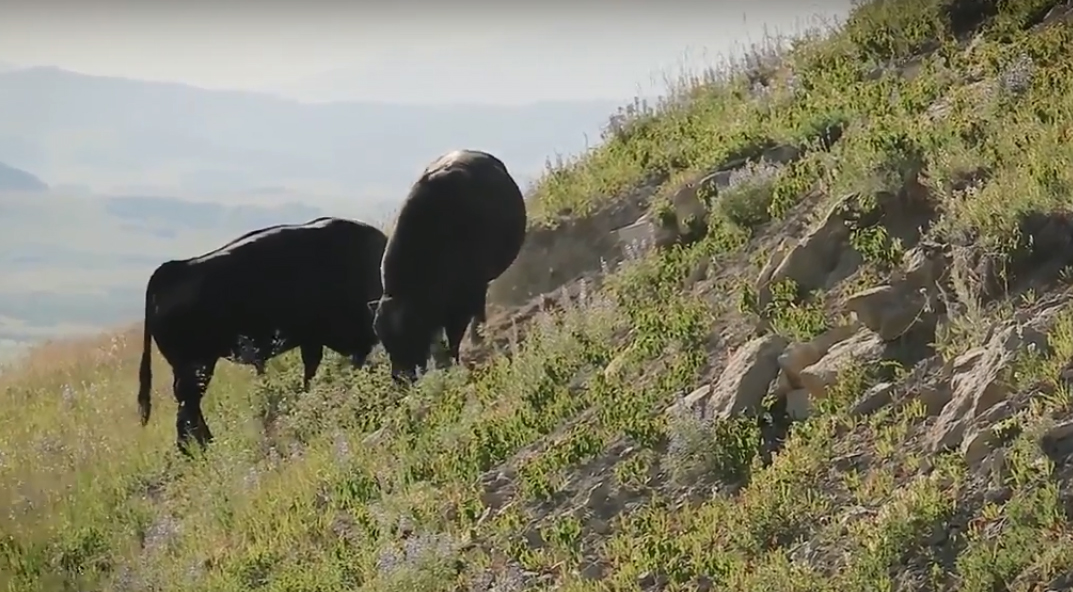
Forages (pastures and harvested roughage) account for approximately 80% of the feed used by beef cattle in Canada. Nearly a third (31%) of Canada’s agricultural land is pasture. This land is not suited for crop production, but it can grow grass which needs to be grazed by animals to remain viable.
Canada’s beef herd is primarily located in the prairies. The southern prairies are drought-prone, and the more northerly growing seasons are too short for many crops. Central and Eastern Canada generally have higher rainfall and longer growing seasons than the prairies, but not all this farmland is suitable for crop production either. Much of this land is too boggy, stony, or bushy to allow cultivation, but it can grow grass.
Grass and other range and pasture plants contain fiber that people can’t digest, but cattle have a specialized microbial population in their stomach (rumen) that allows them to digest fiber, make use of the nutrients, and convert them into high-quality protein that humans can digest. Beef cattle production allows us to produce nutritious protein on land that isn’t suited to cultivation and crop production.
Water use is only half of the picture
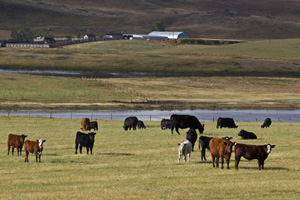
Simply focusing on water use per pound of product ignores the water cycle. The water cycle is important – humans, wheat, corn, lentils, poultry, pork, eggs, milk, forages and beef production all use water, but they don’t use it up. They aren’t sponges that endlessly absorb water. Nearly all the water that people or cattle consume ends up back in the environment through manure, sweat, or water vapor. We know that most of the water plants take up from the soil is transpired back into the air. Like city water, the water that beef processing facilities take out of the river at one end of the plant is treated and returns to the same river at the other end of the plant. New technologies to recycle and re-use water can reduce the amount of water needed for beef processing by 90%.
The pastures and rangelands that support beef production are also an important part of the water cycle. Because these lands are not cultivated, they are covered in living plant material all year round and are anchored by well-developed root systems that hold the soil in place. This above- and below-ground vegetation serves to trap snowfall, slow meltwater movement over the soil surface, and helps reduce runoff, overland flooding, soil erosion, and the movement of silt and nutrients into waterways. In grassland environments, this water often collects in sloughs, pot holes or other low-lying areas that provide valuable nesting sites for birds. When grasslands are converted to crop production, these water bodies are often drained and cultivated. Grasslands also have improved soil porosity due to healthy root growth and earthworm activity. This allows more water to infiltrate the soil and recharge groundwater reserves.
Cattle produce greenhouse gases. Forages and grassland store and sequester them.
Cattle produce methane as a byproduct of digestion, particularly on pasture and other high forage diets. But water is not the only thing that cycles; so does carbon. Plants take carbon dioxide out of the atmosphere, incorporate the carbon into plant structures (roots, stems, leaves, flowers and seeds), and release oxygen back into the atmosphere. Because perennial pasture plants live for many years, they develop an extensive root system which will eventually decay and become part of the soil carbon. Because permanent or perennial pastures are not cultivated and reseeded every year, the carbon sequestered by these plants remains in the soil rather than being released back into the atmosphere. As a result, numerous studies have documented that grasslands have higher soil carbon stocks than adjacent cropland.
Cultivating ecologically sensitive land harms the soil
Cultivating drought-prone areas instead of leaving them in permanent grassland drastically increases the risk of soil erosion, loss of topsoil, and subsequent losses of sequestered soil carbon into the atmosphere. Those losses have occurred across Canada and were particularly notable on the prairies in the ‘Dirty Thirties’. Cultivation has led to the loss of 40-50% of the organic carbon from prairie soils, and 60-70% from central and eastern Canadian soils. Unlike commercial fertilizers, using manure as a fertilizer replenishes organic matter in these soils.
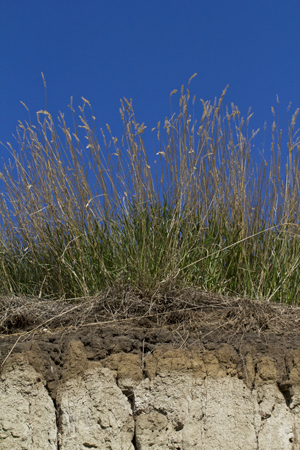
Cultivation also affects soil structure and water infiltration. As a general rule, when lands are left in their natural state, 10% of precipitation runs off, 40% evaporates and 50% enters the groundwater reserves (25% shallow and 25% deep infiltration). When soils are disturbed, water infiltration is reduced. As land is converted to rural development, urbanization and industrial development, runoff increases (20%, 30% and 55%, respectively) and infiltration decreases (42%, 35% and 15%, respectively). The more developed land gets, the less water soaks in (which means less is available for soil organisms, root uptake and plant growth) and the more water runs off (which means erosion, decreased soil productivity, diminished water quality of nearby water bodies and potential flooding).
Reductions in summerfallow and widespread adoption of minimum tillage practices across Canada have slowed these losses in soil structure and water infiltration, but grassland and forage remain the ultimate zero tillage practice.
Maintaining ecologically sensitive grasslands supports healthy soil
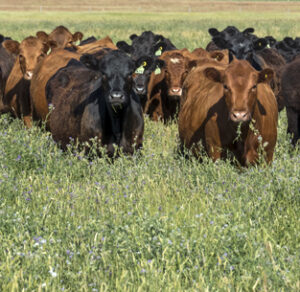
It’s not just dead roots that provide environmental benefits. Because perennial forages aren’t cultivated, and often grow in dry conditions, they grow extensive root systems in their search for moisture. For example, forage legumes like alfalfa develop roots that penetrate 53 to 63% deeper into the soil than chickpeas, lentils and other pulse crops. All legumes can “fix” nitrogen from the air and convert it into soil nitrogen that can improve soil fertility, and forage legumes like alfalfa can fix up to twice as much nitrogen per acre as annual legume crops.
Lands that are prone to periodic flooding or drought benefit from the permanent plant cover that forages provide. The roots and vegetation keep the soil in place so that it doesn’t wash away in a flood or blow away during a drought. These extensive root systems also help improve soil structure and water holding capacity and water infiltration, and allows groundwater reserves to recharge better than croplands.
Home on the range
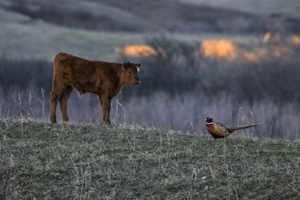
Cattle and soil aren’t the only living things affected when grassland is converted to farmland. Grasslands also provide habitat for small and large mammals, hawks, nesting birds, songbirds and pollinating insects. Converting natural rangeland to crop production results in considerable biodiversity loss, as the native plants, insects, birds, and wildlife that require undisturbed natural habitats do not thrive in cultivated monoculture crops. The World Wildlife Fund has highlighted the negative impact that converting Northern Great Plains rangelands to farmland is having on wildlife populations. If remaining grassland were converted to cropland, in most cases it would not be economical and could be environmentally catastrophic. Over 80% of Canada’s grasslands have already been converted to crop production; this has led to considerable population losses in some species, with up to 87% population declines among some grassland bird species.
The ecological benefits provided by pastures and rangelands are disappearing as more and more acres are converted to cultivated agriculture and urbanization. Canada lost another 5 million acres of grassland between 2011 and 2016 alone. That’s three and a half times the size of Prince Edward Island.
Crops and cattle go well together
Crops, cattle and grasslands need each other. For example, canola crops yield and ripen better when they are pollinated by bees. Because an entire field is seeded at the same time, all the canola plants flower at the same time, and each plant only flowers for two or three weeks. Grasslands provide a home for a wide range of plants that all flower at different times. That means bees have lots of plants to help support them during long periods when annual crops aren’t flowering. Over 140 bee species are reside in Canadian grasslands; bee abundance and diversity are positively related to the presence of grasslands.
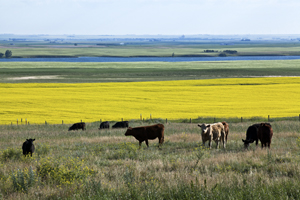
Crops (primarily feed grains) account for roughly 20% of the feed consumed by cattle. Some of these crops were deliberately seeded to produce feed grain for cattle, but not many. For example, barley is an important grain crop in Western Canada. Malt barley (for brewing) generally brings a higher price than feed barley (for livestock). But poor growing or harvesting conditions can produce barley that does not achieve malt grade. Using off-grade malt barley as livestock feed allows it to be recycled into high-quality protein rather than discarding it. If the weather had cooperated and the barley had been accepted for malting, the water used to grow that barley would have contributed to beer’s water footprint. But due to inclement weather, that water contributed to beef’s water footprint instead. A similar scenario occurs for wheat that does not meet the criteria for human consumption.
Cattle also make use of many crop byproducts that humans can’t use. For most crops, only the seed is used for human consumption, whether it is milled for flour, sprouted for brewing, split for pea soup, pressed for oil or cooked and eaten whole. The rest of the plant – the stems, leaves, shells, screenings, hulls, shriveled and cracked seeds, residues from brewing and bio-ethanol production – are useless for human food but are excellent, high quality feed for cattle.
Many environmentally sustainable and economically healthy farm operations produce both beef cattle and crops. In the same way, a balanced, environmentally sustainable, healthy diet includes both plants and beef.
Sit back and take a quick virtual tour of Canada’s rangelands, courtesy of the University of Alberta’s Rangeland Research Institute. It will help you to see greenhouse gas or water use numbers in catchy headlines in perspective, and to remember how each serving of beef you eat helps maintain ecologically sensitive soils, natural habitats, watersheds, and critical landscapes that support a wide variety of threatened and endangered species.
Click here to subscribe to the BCRC Blog and receive email notifications when new content is posted.
The sharing or reprinting of BCRC Blog articles is welcome and encouraged. Please provide acknowledgement to the Beef Cattle Research Council, list the website address, www.BeefResearch.ca, and let us know you chose to share the article by emailing us at [email protected].
We welcome your questions, comments and suggestions. Contact us directly or generate public discussion by posting your thoughts below.
